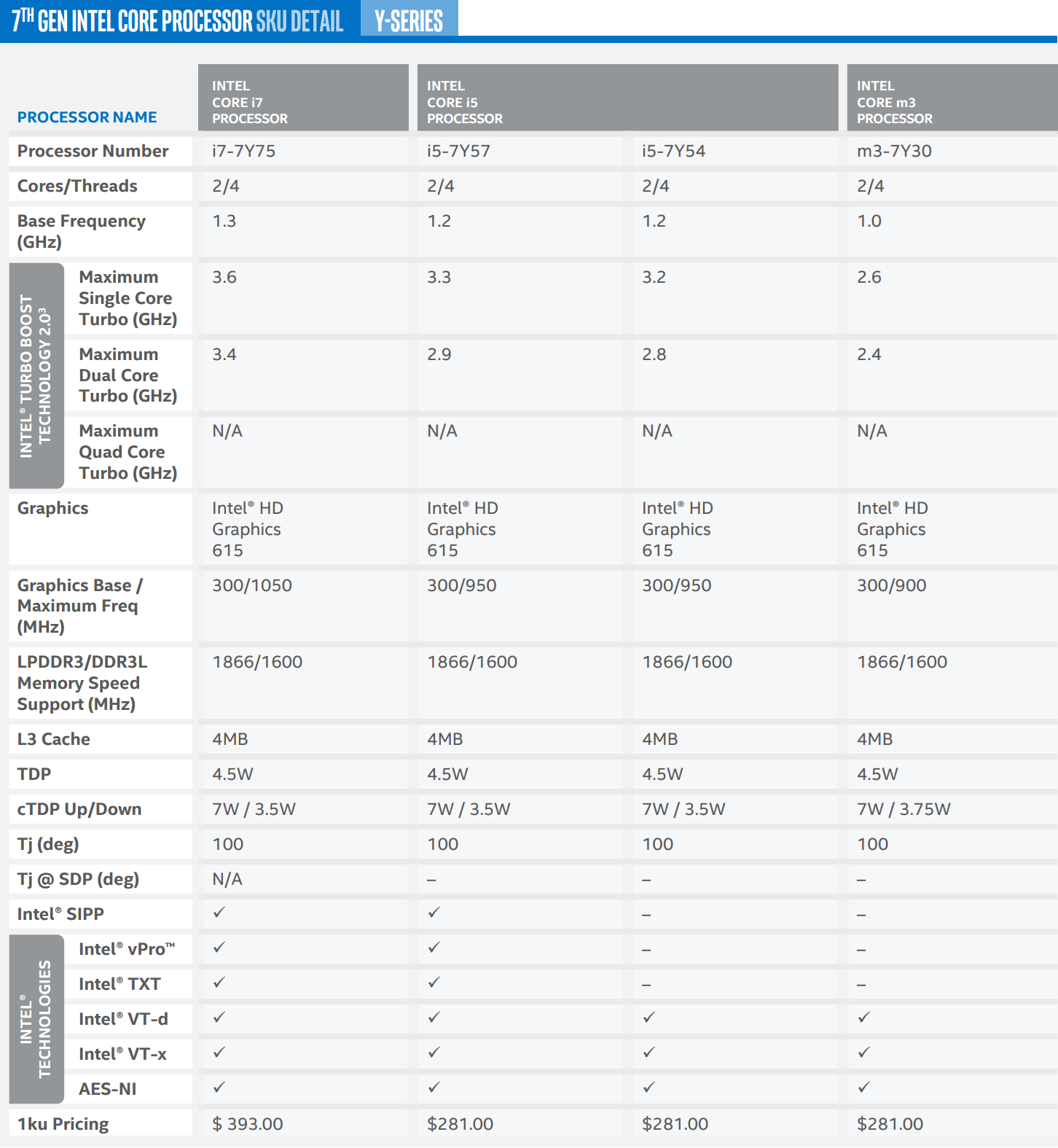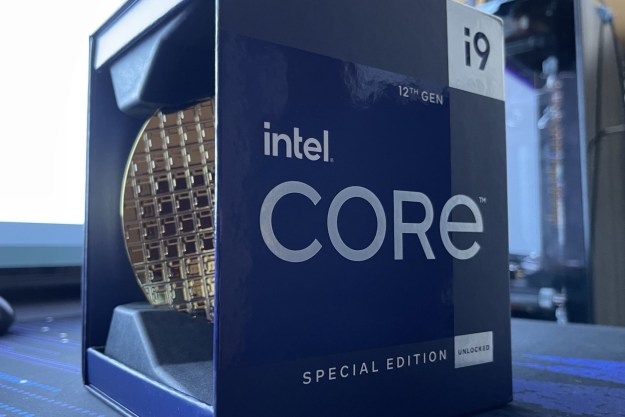Intel’s 7th-generation Intel Core processor line, code-named Kaby Lake, technically launched at IFA 2016. But it was a limited launch focused on mobile, dual-core processors. Most of the Intel product line remained on 6th-generation technology.
Until now. On January 3, Intel announced its full line of 7th-generation Intel Core processors, as well as a couple related Xeon mobile processors. Notably, the lineup includes everything from 4.5-watt to 91-watt processors, ranging from two to four cores, targeting systems from 2-in-1s to desktop workstations. There’s a little something for everyone.
You can read the full details of each line-up below, but here are the basics.
What’s new in the 7th generation?
Intel’s new product line looks a lot like its old one. The most notable change is one that already happened during the IFA 2016 launch – Intel has mostly abandoned “Core M” branding. Instead, its most efficient dual-core chips will be known as the “Y-Series.” They still have a thermal design power of 4.5 watts, which means they sip juice conservatively. And they still pair a very low base frequency with an extremely high Turbo Boost maximum.
Laptop buyers might also want to take note of the new Intel Core i5-7440HQ and Core i5-7300HQ. Intel first introduced Core i5 mobile chips in the last generation, but we suspect most users aren’t aware of them. Keep an eye out for these if you want a powerful, yet relatively affordable laptop.
Finally, the rumored overclockable Core i3 processor is confirmed to be true. The Intel Core i3-7350K is a dual-core chip with Hyper-Threading. It has a base clock of 4.2 GHz, and lacks the Turbo Boost feature. Intel’s list price for it is $168 – expect it to be a few bucks more at retail.
The desktop processors, primarily found in the S-Series, debut alongside companion chipsets, though the physical chip size and pin count hasn’t changed (the standard is still LGA 1511). Older LGA1511 compatible motherboards will be able to handle the 7th-gen Intel Core chips if the motherboard manufacturer issues a BIOS update.
For the most part, the chipsets aren’t shockers. The main new feature is one that can’t be used yet — compatibility with Intel’s upcoming Optane memory, expected later this year. Optane, which will reportedly boost drive speed beyond even NVMe drives, is exciting — but not available yet.
Otherwise, the chipsets add a few more I/O lanes, so they can technically handle more ports or add-on cards. But this benefit won’t be of much consequence for home users.
Intel’s 7th-generation Intel Core lineup isn’t going to knock anyone’s socks off. These chips are built on the same 14-nanometer processor as the 6th generation, with some improvements (Intel calls it “14-nanometer+”), and the architecture is similar. Don’t expect stunning improvements to performance. Still, some users were waiting to pounce on the latest upgrade, and it’s nice to see it arrive.
Intel Y-Series
The Y-Series is Intel’s super-low-power line. These chips have a thermal design power of 4.5 watts, the lowest of any Intel Core processor.

There are no surprises here, because this entire line was already launched at IFA 2016. The story is simple. Low base clock speeds, paired with high Turbo Boost speeds. In theory, this gives the chip a great deal of room to operate at whatever speed makes the most sense. The chip can conserve battery by running at a low clock speed, or hit Turbo and reach performance near that of a “standard” U-Series dual-core chip.
In past reviews, these chips have performed noticeably worse than Intel dual-core chips designed to draw more power. That’s physics – more juice in means more performance. With that said, the Y-Series is adequate for most everyday tasks, and most designs based on it are fanless.
Intel U-Series
Intel also debuted some of its 7th-generation U-Series processors at IFA 2016, and we’ve already tested the Core i5-7200U and Core i7-7500U in several laptops. While they don’t blow away the previous generation, they do provide a respectable bump of 10 to 20 percent, depending on the chip and the workload.
At CES 2017, Intel has augmented the U-Series with a few new 15-watt processors that have Intel Iris Plus Graphics 640. These were not previously available. These chips should have similar processor performance to those that arrived at IFA 2016, but will have better graphics performance.
Then there’s the 28-watt U-Series chips. These are the most powerful mobile dual-core processors in the 7th-generation line. In addition to slightly higher clock speeds than 15-watt counterparts, these chips have Intel Iris Plus 650 Graphics, the most powerful mobile graphics available in Intel hardware.
Note, though, that Intel hasn’t significantly revised its integrated graphics component for the new generation.
Intel H-Series
While Intel led the 7th generation with mobile at IFA 2016, it didn’t debut any quad-core chips. All high-end gaming and workstation laptops had to make do with the 6th generation — until now.
The Xeon processors might cause a few eyebrows to raise, though Intel started to introduce Xeon mobile hardware with the last generation. These processors are extremely quick. The E3-1535M v6, the quickest of the pair, is rated for higher clock speeds than the fastest Core i7 mobile quad. However, don’t expect to see these Xeon chips outside of mobile workstations. They’re really meant for the professional market, and priced accordingly.
Elsewhere, the lineup is basically a copy of the previous generation. The available SKUs, and each processor’s performance relative to its peers, hasn’t changed much.
Skeptical buyers might be concerned that it appears some SKUs have lower “maximum quad core Turbo” speeds than the maximum Turbo Boost speed listed on chips from the previous generation. This is because of Intel’s “Turbo Boost 2.0,” which allows more precise variations in performance, and now quotes maximum performance on a single-core, dual-core, and quad-core basis.
In practice, the new chips should average speeds higher than before, though we must take Intel’s word for it. We’ve not reviewed an Intel Core 7th-gen mobile quad yet.
Intel S-Series
Last, but not least, is the S-Series, which makes up the entirety of Intel’s desktop line. These cover the range from Intel’s Core i7-7700K, the company’s best quad-core, to the affordable Intel Core i3-7100.
Again, the SKUs here are what we expected, for the most part. The addition of the Core i3-7350K, which is unlocked for overclocking, is nice to see. But its list price is rather high, so we’re not sure how much value it will provide for all but the most extreme tinkerers.
New chipsets
A new processor line usually means the introduction of new chipsets, and there’s no exception here. However, Intel’s new line is very similar to what was previously available.
It starts with the B250, a chipset that is aimed at enterprise systems. It has 16 PCI Express 3.0 lanes for graphics, along with 12 additional PCI Express Lanes 3.0 for other uses. Storage support includes SATA ports. It can handle USB with 12 USB 3.0 ports.
That’s followed by the H270, an entry-level chipset for general purpose systems. It has 16 PCI Express 3.0 lanes for graphics, but upgrades to 20 additional PCI Express 3.0 lanes for other purposes. Six SATA ports are supported. USB options include up to eight USB 3.0 ports and 14 USB 2.0 ports.
Next up is the Q250/270, which is another business-oriented platform. It has up to 16 PCI Express 3.0 lanes for graphics, but can split those into other configurations, such as 2 x 8 lanes, or 1 x 8 with 2 x 4. That’s supported by 24 PCI Express 3.0 ports for additional connectivity. Six SATA ports are available. USB support includes up to 10 USB 3.0 and up to 14 USB 2.0.
Last, but far from least, is Intel Z270. This chipset is the flagship. Its specifications are virtually identical to the Q250/270, however, there are some feature differences. The main thing to note is that Q250/270 includes support for Active Management Technology, which helps IT departments control large numbers of client PCs. The Z270, meanwhile, focuses on overclocking. You’ll need it if you want to crank an unlocked Intel processor to its limit.
For the most part, home PC builders are only going to worry about H270 and Z270. The former is a good choice for a budget motherboard if you’re building a general purpose PC, or even a budget gaming rig. The Z270, on the other hand, will be the chipset of choice for enthusiasts.
These chipsets also provide support for Intel Optane Memory, the company’s upcoming solution for ultrafast storage. That’s not out yet, but it may become a dealmaker once it arrives later this year.
Editors' Recommendations
- Intel Core i5 vs. i7: Which CPU is right for you in 2023?
- Intel’s Core i9-13900KS hits 6GHz out of the box, but there’s a catch
- Intel’s 24-core laptop CPU might outclass desktop i9 processors
- Intel Core i9-13900K vs. Core i9-12900K: Is it worth the upgrade?
- Ryzen 7 7700X vs. Intel Core i7-12700K










